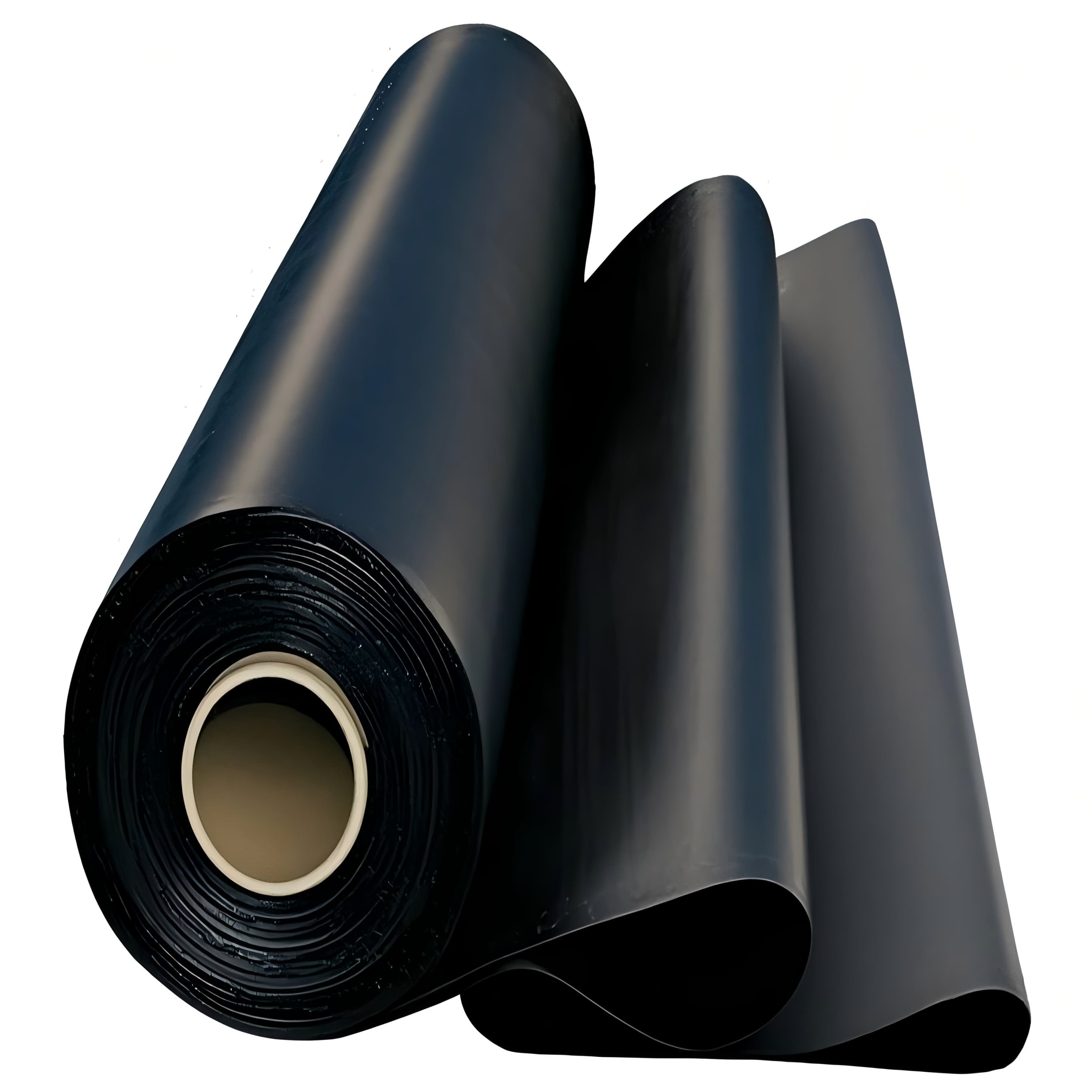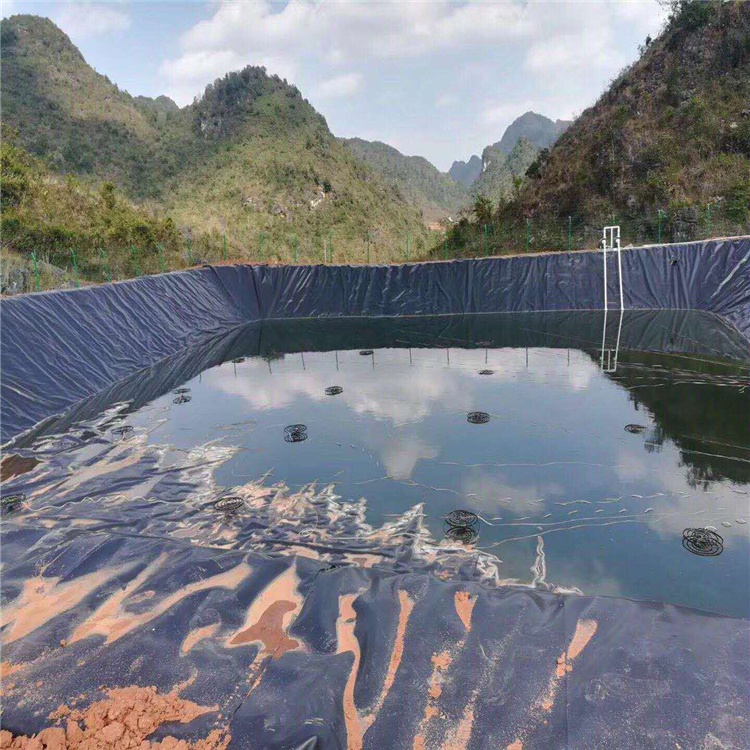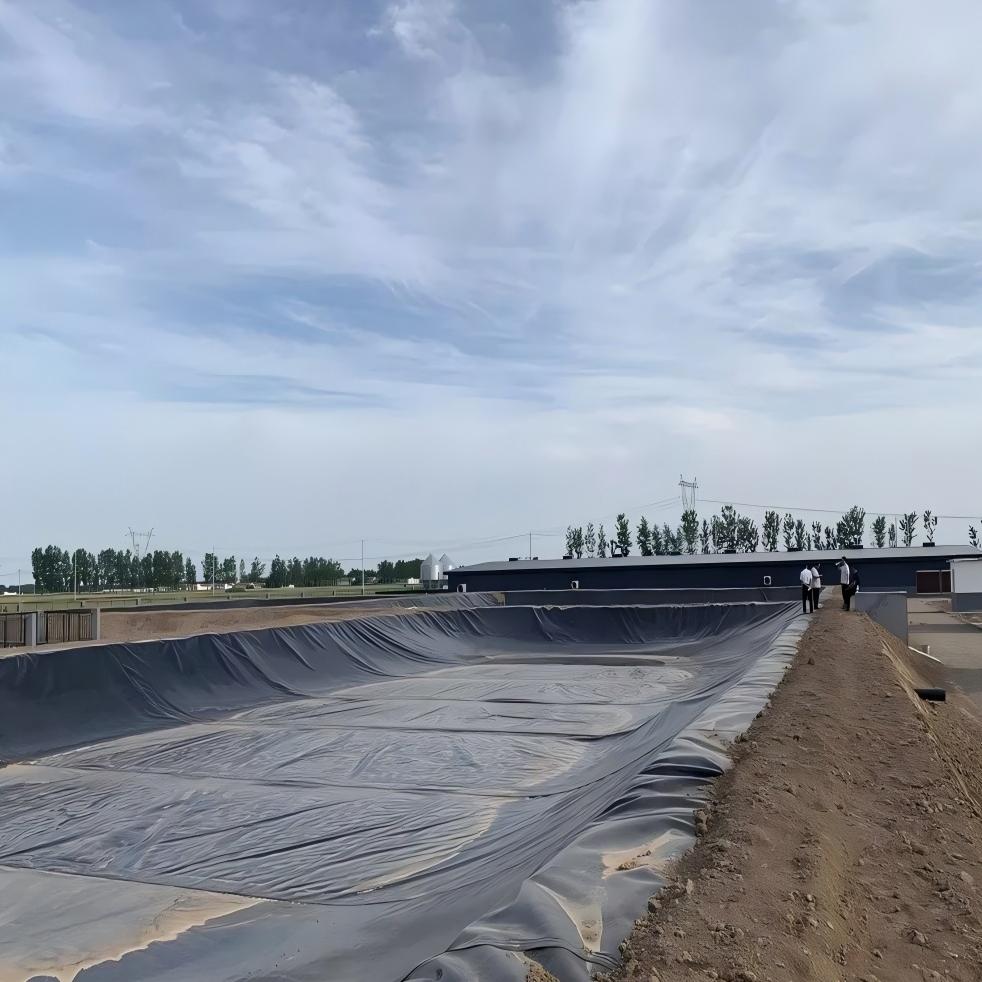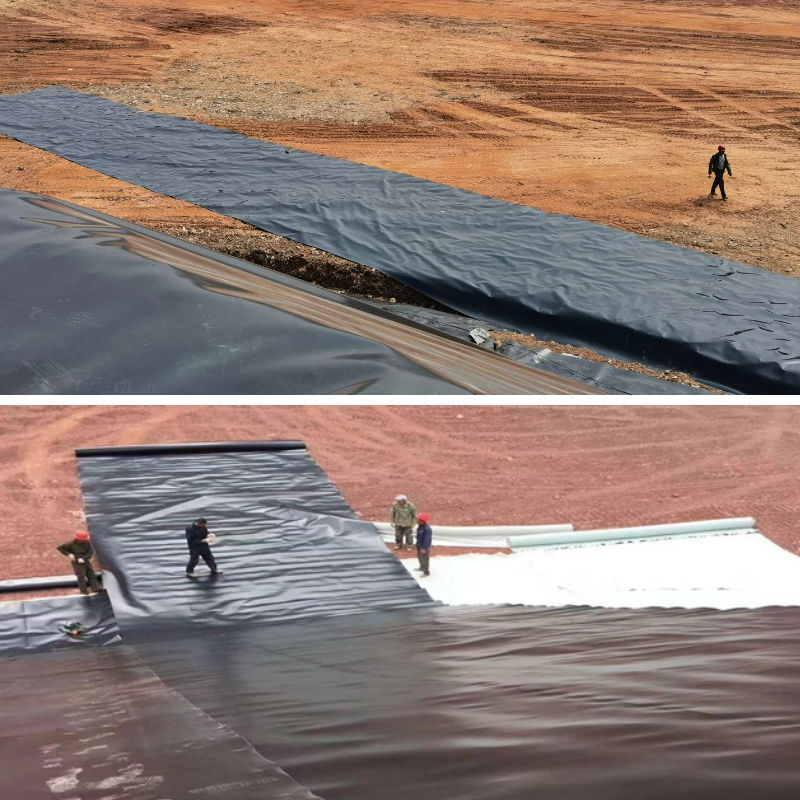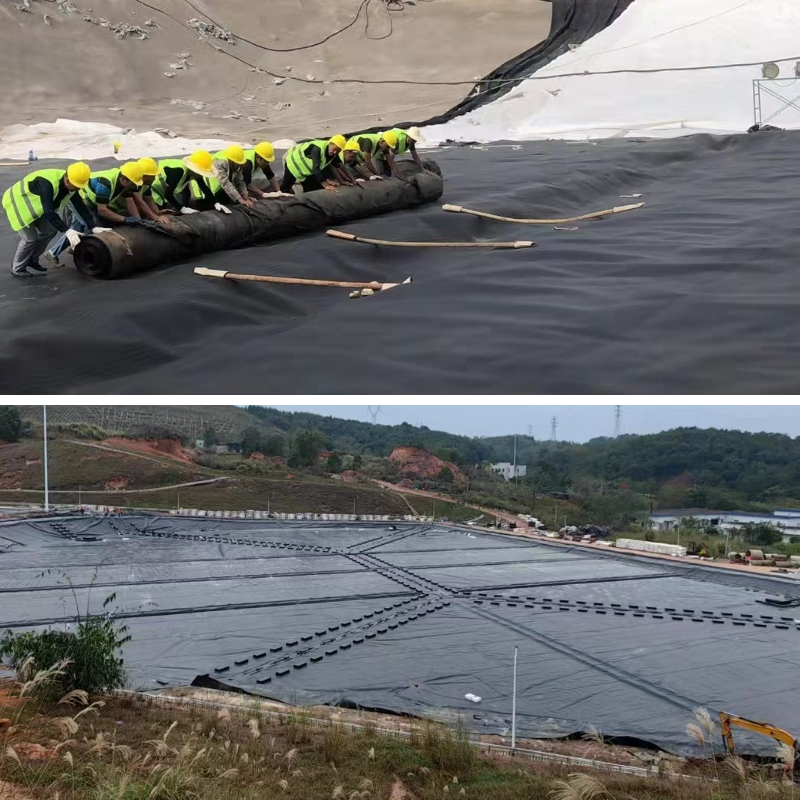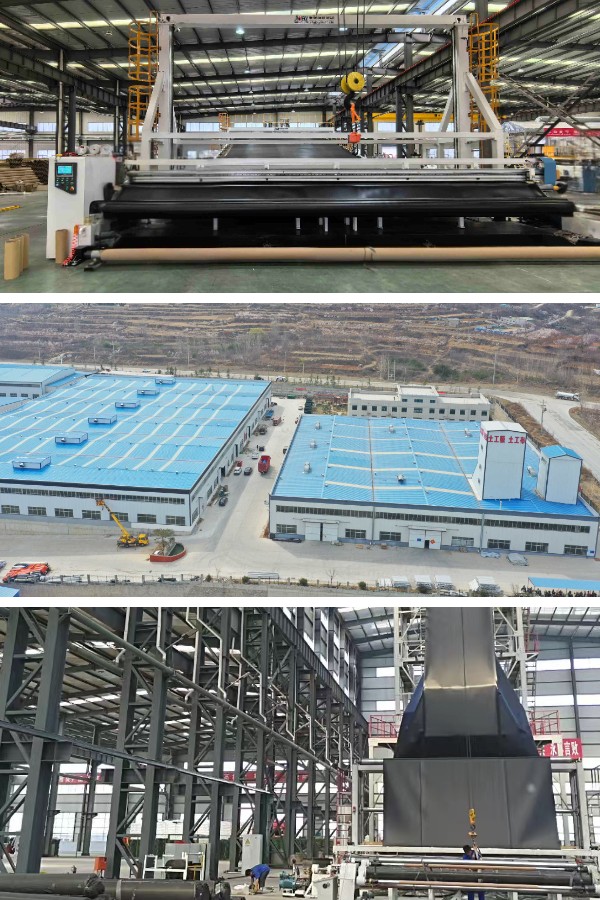HDPE Fish Pond Liner
1. Strong impermeability:The molecular structure is tight and non-porous, which can firmly lock the pool water and nutrients, significantly reducing the cost of water and fertilizer replenishment.
2. High durability:Resistant to ultraviolet rays, acid and alkali corrosion, and friction, it can last for 10-20 years under normal use.
3. Easy to operate:It is flexible and can be cut and spliced according to the shape of the fishpond. Its surface is smooth, and daily rinsing can keep it clean.
4. Safe and environmentally friendly:It does not release harmful substances at room temperature, is harmless to fish and aquatic plants, and is suitable for ecological breeding.
Product Introduction
1. Basic Properties: Material and Safety Base
Material Type: HDPE Fish Pond Liner made from high-density polyethylene resin through extrusion molding, belonging to flexible polymer materials.
Physical Properties: High density (0.941-0.965g/cm³), with a dense molecular structure and no pores; it has a certain degree of flexibility at room temperature, can be bent but is not easy to break.
Safety Standards: Complies with food-grade or aquaculture environmental protection standards, does not release toxic or harmful substances at room temperature, and has no irritation to aquatic organisms.
2. Core Functions: Solving Key Pain Points of Fish Ponds
Anti-seepage and Water Locking: Blocks the seepage of pool water and nutrient solution into the soil, and at the same time prevents reverse infiltration of underground sewage into the fish pond, reducing the frequency of water replenishment and nutrient loss.
Protection of Pool Body and Water Quality: Isolates sediment and impurities at the bottom of the fish pond to avoid water turbidity; it can also prevent the pool walls (such as earthen ponds and masonry ponds) from being damaged by water erosion.
Stabilizing the Ecological Environment: Reduces water quality fluctuations caused by leakage, provides a more stable growth environment for fish and aquatic plants, and reduces the risk of diseases.
3. Main Features: Key Advantages in Use
Strong Durability: Excellent resistance to UV aging, can last 10-20 years when used outdoors; at the same time, it is resistant to acid and alkali, resistant to fish friction, and not easy to be corroded by disinfectants or fish feces.
Flexible Construction: Can be cut and thermally bonded according to the irregular shape of the fish pond (such as circular, special-shaped ponds), fitting the bottom and walls of the pond, with low construction difficulty.
Easy Maintenance: The surface is smooth, not easy to attach algae and dirt, daily cleaning only requires simple flushing, no need for frequent pool cleaning or repair.
Product Parameters
Metric | ASTM | unit | Test value | Minimum test frequency | ||||||
test method | 0.75 mm | 1.00 mm | 1.25 mm | 1.50 mm | 2.00 mm | 2.50mm | 3.00 mm | |||
Minimum average thickness | D5199 | mm | 0.75 | 1 | 1.25 | 1.5 | 2 | 2.5 | 3 | Per volume |
Minimum value (any one of 10) | -10% | -10% | -10% | -10% | -10% | -10% | -10% | |||
minimum density | D 1505/D 792 | g/cm3 | 0.94 | 0.94 | 0.94 | 0.94 | 0.94 | 0.94 | 0.94 | 90,000 kg |
Minimum average tensile performance (1) | D638 Type IV | |||||||||
Breakage strength, | N/mm | 20 | 27 | 33 | 40 | 53 | 67 | 80 | 9,000 kg | |
yield strength | N/mm | 11 | 15 | 18 | 22 | 29 | 37 | 44 | ||
Strain extension, | % | 700 | 700 | 700 | 700 | 700 | 700 | 700 | ||
yield extension | % | 12 | 12 | 12 | 12 | 12 | 12 | 12 | ||
Minimum strength of right-angle tear | D 1004 | N | 93 | 125 | 156 | 187 | 249 | 311 | 374 | 20,000 kg |
Minimum puncture strength | D4833 | N | 240 | 320 | 400 | 480 | 640 | 800 | 960 | 20,000 kg |
Constant tensile load stress cracking (2) | D5397 | hour | 300 | 300 | 300 | 300 | 300 | 300 | 300 | Based on GRI GM-10 |
Carbon black content | D 1603(3) | % | 2.0-3.0 | 2.0-3.0 | 2.0-3.0 | 2.0-3.0 | 2.0-3.0 | 2.0-3.0 | 2.0-3.0 | 9,000 kg |
Carbon black dispersion | D5596 | Note (4) | Note (4) | Note (4) | Note (4) | Note (4) | Note (4) | Note (4) | 20,000 kg | |
Oxygen induction time (OIT) (5) | 90,000 kg | |||||||||
(a) Standard OIT | D3895 | minute | 100 | 100 | 100 | 100 | 100 | 100 | 100 | |
(b) high-handed OIT | D5885 | minute | 400 | 400 | 400 | 400 | 400 | 400 | 400 | |
85℃ Oven aging (minimum average) (5)(6) | Per formula | |||||||||
(A) Standard OIT is retained after 90 days | D 5721 | % | 55 | 55 | 55 | 55 | 55 | 55 | 55 | |
(B) High voltage OIT is retained for 90 days | D 3895 D5885 | % | 80 | 80 | 80 | 80 | 80 | 80 | 80 | |
Ultraviolet resistance (7) | Per formula | |||||||||
(a) standard OIT | D3895 | Note (8) 50 | ||||||||
(b) Retention of high pressure OIT after 1600 hours (9) | D5885 | % | ||||||||
Product Application
1.Aquaculture Scenario: Adapting to Diverse Aquaculture Needs, Reducing Costs and Ensuring Production
It covers both conventional and special aquaculture. It is suitable not only for traditional pond culture of freshwater fish, shrimp, and crabs but also for intensive culture ponds of benthic aquatic products such as soft-shelled turtles and loaches, preventing water quality deterioration caused by sediment accumulation.Beyond its core function of water retention and anti-seepage, it also stabilizes the water temperature in the pond (reducing temperature differences caused by soil heat conduction), lowering the energy costs of frequent water replenishment and replacement. Meanwhile, it isolates aquaculture wastewater from the underlying soil, preventing pollutants such as nitrogen and phosphorus from seeping into groundwater and complying with environmental protection standards for aquaculture.It is adaptable to different scales, from small scattered aquaculture ponds of individual farmers to large-scale contiguous ponds in intensive aquaculture bases, all of which can be fully covered through cutting and splicing.
2.Landscape and Ornamental Scenario: Balancing Aesthetics and Practicality, Simplifying Maintenance
Its application scenarios are wide-ranging, including central landscape ponds in urban parks, water feature landscapes in residential gardens, small ornamental fish ponds in home courtyards, and even waterfront landscape ponds in homestays of cultural and tourism projects, as well as interactive water feature ponds in theme parks.In addition to basic anti-seepage, it can enhance landscape coordination through color selection (e.g., black liners make the water appear clear, while green liners blend into green plant environments). It fits well with landscaping elements such as rockeries, fountains, and aquatic plants without damaging the overall visual effect.It reduces maintenance difficulty: its smooth surface is less prone to moss and algae attachment. Daily maintenance only requires rinsing with high-pressure water guns, eliminating the need for frequent drainage and pond cleaning and avoiding damage to landscape integrity.
3.Ecological Restoration Scenario: Supporting Ecosystem Construction and Stabilizing the Environment
It is applicable to various ecological restoration projects, including constructed wetlands (such as urban rainwater and flood regulation wetlands, purification wetlands along riverbanks), waterlogged areas in mine ecological restoration, and local restoration enclosure ponds in degraded lakes.Its core value lies in building a stable aquatic environment. Through anti-seepage, it prevents the leakage of restored water bodies, provides fixed growth carriers for aquatic plants (such as reeds and calamus) and microorganisms (such as nitrifying bacteria), and helps restore the water’s self-purification capacity. At the same time, it can isolate surrounding contaminated soil (such as heavy metal-contaminated soil in mines), preventing harmful substances from seeping into the restored water bodies and ensuring the effectiveness of ecological restoration.It meets the demand for ecological friendliness: the environmentally friendly HDPE material does not release harmful substances, does not cause secondary harm to organisms such as fish, shrimp, and birds in the restoration area, and complies with the "low-intervention" principle of ecological restoration.
Summary
In conclusion, the core of HDPE fish pond liner applications is "based on anti-seepage, extending value to meet scenario-specific needs": it focuses on "cost reduction, efficiency improvement + compliance with environmental protection standards" in aquaculture, pursues "aesthetic adaptation + simplified maintenance" in landscape and ornamental scenarios, and emphasizes "environmental stability + ecological friendliness" in ecological restoration. This multi-scenario adaptability makes it not just a material for solving water leakage problems, but also a key support for "matching functions with needs" in various water-related scenarios.


